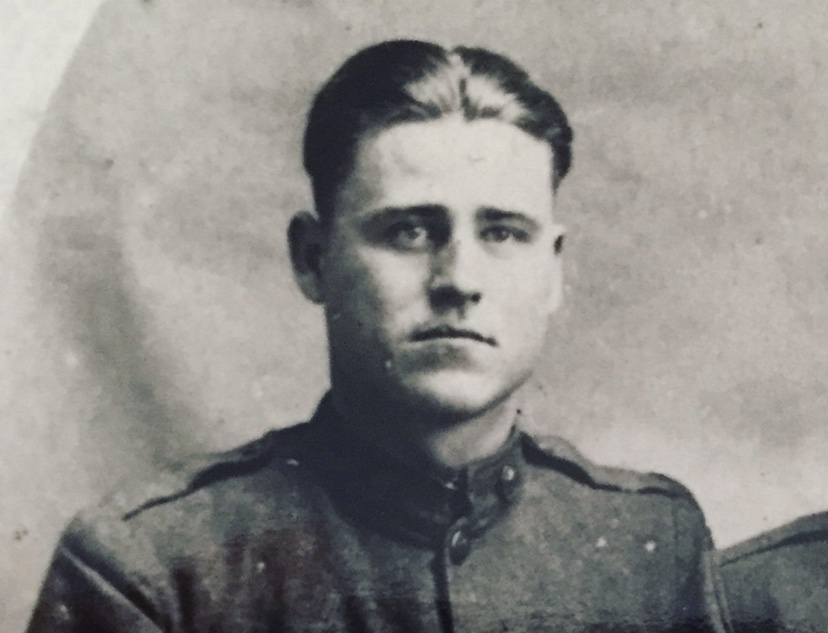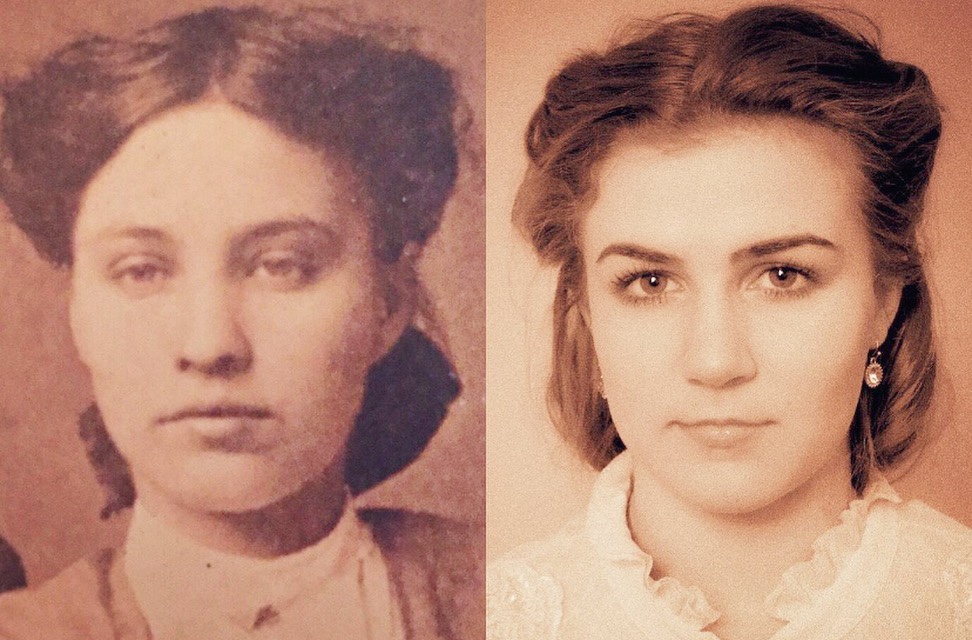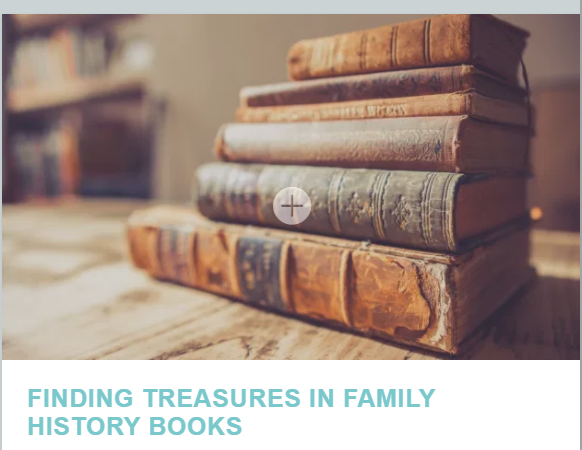
In Remembrance of A WWI Hero
In honor of Veteran’s Day and the armistice that ended WWI 101 years ago today (on the 11th hour on the 11th day in the 11th month), I’d like to share the story of my own personal war hero- my great- grandfather.
On July 16, 1892, in the quaint town of Taylorsville, Mississippi, my great grandfather, William Grover Yelverton, was born. Life was simple for that farm boy with sky blue eyes and a smile that produced two dimples. He was raised in a large family that grew up on love, hard work, and good ole southern food and values. As his granddaughter, I have the honor of affectionately calling him “Daddy Grover”.
In the summer of 1917, Grover was drafted into “the war to end all wars.” For a young man whom had never been anywhere but home, I can only imagine what he felt at this call. I have a photo of him that was taken at the end of his basic training that to this day sits framed on my piano. The young man I see in that photo was handsome, confident and courageous. I believe he was excited for unseen adventures as he donned a crisp new uniform, haircut and skills.
Since his media exposure consisted solely of the small local newspaper, his expectations of the outside world were most likely created in the chambers of his own imagination. Although I am certain there were fears of the unknown, I believe his bravery stood out front and center. I am so thankful we have a photo of that unseasoned boy because the man that returned home at the end of the war was a different person.
Upon receiving his draft notice, he was assigned to the 18th (this later became the 39th) Infantry Division, 114th Engineers and sent to Camp Beauregard, LA for training. Sickness and disease ran rampant at Camp Beauregard. They were plagued with outbreaks of measles, meningitis, and Spanish Flu. This led to lobar pneumonia in many patients; overcrowding the already taxed hospital facilities. The soldiers were anxious to get to France because of bug infestations and poor conditions.
When he finally reached France, Grover’s varied responsibilities included building bridges, roads and railroads for the 1st Army Corps. The roads they constructed through the Argonne forest were especially treacherous because of the mountainous terrain. They had to cut the path through huge timber and rocks and then level the ground. This operation was vital to success in the war so that tanks, vehicles, and equipment could be taken to the front lines. The engineers also built pontoon bridges across the Meuse and Rhine Rivers for crossing.
On one occasion, as the 39th division was in the river constructing a bridge, German tanks and soldiers pulled up to the river bank. American tanks pulled up on the other side and an attack ensued. Grover and the other engineers were caught in the crossfire and had to fight hard and fast to survive. Being the largest and bloodiest battle of WWI, infantry divisions were quickly depleted in the Meuse-Argonne Offensive. Manpower situations became so desperate that all available troops, including those slated as training, depot or engineer divisions; such as the 39th; were deployed to the front lines. That included my great-grandpa. He wasn’t trained as a rifleman, but he bravely fulfilled that role when he was called.
In the midst of battle, Grover suffered the debilitating effects of mustard gas at the hands of the German army. Although he was initially given a gas mask, he was told during an inspection that it was defective and to throw it away. A new one was supposed to be issued to him but was never delivered. The mustard gas he was exposed to caused permanent damage to his lungs and significant respiratory issues for the rest of his life.
During the war, homing pigeons were used as a new tactic to transfer messages between military lines. The birds carried letters in small canisters around their necks or legs. When they landed in the coop, a bell would ring and a soldier would remove the message from the canister. The 39th division was responsible for several war pigeons and Grover took great pride in caring for them. He mourned over his birds that were shot by enemy troops and tried his best to keep them safe, clean and comfortable. His love of animals, even in time of war, exemplified his loving heart and protective nature.
The multifarious efforts from the engineers and their assistance in combat were such an advantage to Allied forces in WWI that Germany began to pull back and ultimately, the war came to an end on November 11, 1918. Five months later, my great-grandpa’s unit, the 114th Engineers, returned home to Newport News, Virginia. By the end of his military career, Grover Yelverton was promoted to the rank of Corporal.
After Grover returned from the war, he married Wessie Butler, a young school teacher from Mize, Mississippi. Industry was changing the world and it was an exciting time in America. For a time, Grover worked on the railroad, a skill he learned in the war, but the lung damage he sustained combined with the physical requirements put him at a disadvantage. His employers were not sympathetic to his plight and rebuked him at times for not working fast enough. He eventually made the difficult decision to trade in his engineering days for farming.
Farming was a livelihood where he could work at his own pace and was a blessing to his young family during the Great Depression. Farming didn’t fill their pocketbooks, but it did fill their bellies. Grover and Wessie became the parents of nine beautiful children. Around 1938, they bought 40 acres of land and built a home and bigger farm.
The trauma of war created many other struggles for this good man. Loud or sudden noises would make him jumpy and give him flashbacks. My grandmother (his daughter), remembered a time she was in the field with her dad. The approaching drone of a small twin-engine plane in the distance caused him to jump and run toward the trees for cover. That was twenty years or more after he had been in the war and yet, the trauma still lingered.
At that time, the term “shell-shocked” was newly coined and highly misunderstood. Originally thought to have been brain damage caused by exploding shells, soldiers and veterans who experienced this were considered emotionally weak, lazy and cowardly. They were often reprimanded, labeled, court-martialed and some were even executed for this condition. Once, while confiding in a counselor at the VA hospital about some of his symptoms, Daddy Grover was denied sympathy but told he was probably “just schizophrenic”. Dejected, he vowed to never return to the VA.
With such limited resources, many veterans turned to alcohol to self-medicate but thankfully, somehow, my great-grandpa escaped that trap. Instead, he found therapy in nature- gardening and taking long walks in the woods. I wonder what occupied his thoughts on those moments of solitude. I imagine he battled feelings of inadequacy, fear, and anxiety but I also hope that he felt God’s love and grace as he navigated through those storms of life. He found companionship in his beloved mule, Henry, but ultimately, his oldest son, “Brother”, became his best friend and confidant. Daddy Grover was very protective of his children and made it his personal responsibility to keep others out of harm’s way. It is my personal belief that his strong nature to protect and defend was a blessing to many during his war days.
For the man whose future at one point seemed full of possibility and adventure, those ambitions were ultimately shelved for a simpler life. He gave so much to our freedoms and the price he paid was loss of respect and health. And though he may have been disheartened by his limitations, the time he spent sharing simple joys with his children and grandchildren- like how to pull up a row of peanuts in one fell swoop or how to cut a watermelon like a champ are the moments I wish I could have witnessed with my own eyes.
After a lifetime of wheezing, pain, and coughing, William Grover Yelverton died in 1965 at the age of 73 from lung cancer due to damage sustained from mustard gas. I never got to know him in this life, but earthly bounds can’t break the connection I feel to him.
Today marks 101 years since the Armistice was signed that ended WWI and I’d like to pay homage to him and that great event that preserved my great-grandfather’s life, and gave me the opportunity to be born. Although this tribute to Daddy Grover is long overdue, his sacrifice has never expired. The opportunities he dreamed of and fought for may not have been enjoyed in his own life, but were gifted to me instead. I am humbled to have him as my hero.
In honor of Veteran’s Day, I would like to express my gratitude to all who have sacrificed- veterans and their families, friends and communities- that personally paid for our freedom. Thank you!





